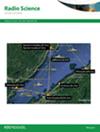基于改进型 Vgg16-Unet 的 VLF 恒频电磁波频率自动提取系统
IF 1.6
4区 地球科学
Q3 ASTRONOMY & ASTROPHYSICS
引用次数: 0
摘要
恒频电磁波(CFEW)是指频率恒定的电磁波。人造恒频电磁波主要用于无线通信、科学研究、全球导航和定位系统以及军用雷达。CFEW 在频谱图上表现出高于背景的水平线特征。本研究以中国地震电磁卫星(CSES)电磁场探测器(EFD)采集的甚低频(VLF)波形数据和功率谱数据为研究对象。我们利用深度学习技术构建了一个改进的 Vgg16-Unet 模型,用于自动检测时频频谱图上的水平线并提取其频率。首先,我们使用短时傅里叶变换将波形数据转换为时长为 2 秒的时频频谱图。然后,我们使用 Labelme 工具在时频频谱图上手动标注水平线,建立数据集。接下来,我们建立并改进 Vgg16-Unet 深度学习模型。最后,我们使用数据集对该模型进行训练和测试。统计实验结果表明,线条检测的错误率为 0,说明模型可靠性高,参数少,计算速度快,适合实际应用。我们不仅能通过模型检测到线路,还能获得它们的频率。此外,在批量生成的 CFEW 功率频谱图中,我们发现了一些不稳定现象,如频率偏移和波动,这有助于理解 CFEW 在电离层中的传播机制,提高相关系统的精度。本文章由计算机程序翻译,如有差异,请以英文原文为准。
Automatic extraction of VLF constant-frequency electromagnetic wave frequency based on an improved Vgg16-Unet
Constant Frequency Electromagnetic Waves (CFEWs) refer to electromagnetic waves with a constant frequency. Man-made CFEWs are mainly used in wireless communication, scientific research, global navigation and positioning systems, and military radar. CFEWs exhibit horizontal line characteristics higher than the background on spectrograms. In this study, we focus on Very Low Frequency (VLF) waveform data and power spectral data collected by the China Seismo-Electromagnetic Satellite (CSES) Electromagnetic Field Detector (EFD). We utilize deep learning techniques to construct an improved Vgg16-Unet model for automatically detecting horizontal lines on time-frequency spectrogram and extracting their frequencies. First, we transform waveform data into time-frequency spectrogram with a duration of 2 s using Short-Time Fourier Transform. Then, we manually label horizontal lines on the time-frequency spectrogram using the Labelme tool to establish the dataset. Next, we establish and improve the Vgg16-Unet deep learning model. Finally, we train and test the model using the dataset. Statistical experimental results show that the error rate of line detection is 0, indicating high reliability of the model, with fewer parameters and fast computation speed suitable for practical applications. Not only do we detect lines through the model, but we also obtain their frequencies. Additionally, in batch-generated power spectrogram of CFEWs, we discover some unstable phenomena such as frequency shifts and fluctuations, which contribute to understanding the propagation mechanism of CFEWs in the ionosphere and improving the accuracy of related systems.
求助全文
通过发布文献求助,成功后即可免费获取论文全文。
去求助
来源期刊

Radio Science
工程技术-地球化学与地球物理
CiteScore
3.30
自引率
12.50%
发文量
112
审稿时长
1 months
期刊介绍:
Radio Science (RDS) publishes original scientific contributions on radio-frequency electromagnetic-propagation and its applications. Contributions covering measurement, modelling, prediction and forecasting techniques pertinent to fields and waves - including antennas, signals and systems, the terrestrial and space environment and radio propagation problems in radio astronomy - are welcome. Contributions may address propagation through, interaction with, and remote sensing of structures, geophysical media, plasmas, and materials, as well as the application of radio frequency electromagnetic techniques to remote sensing of the Earth and other bodies in the solar system.
 求助内容:
求助内容: 应助结果提醒方式:
应助结果提醒方式:


